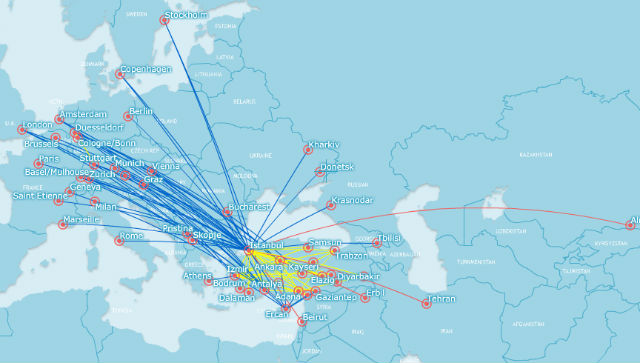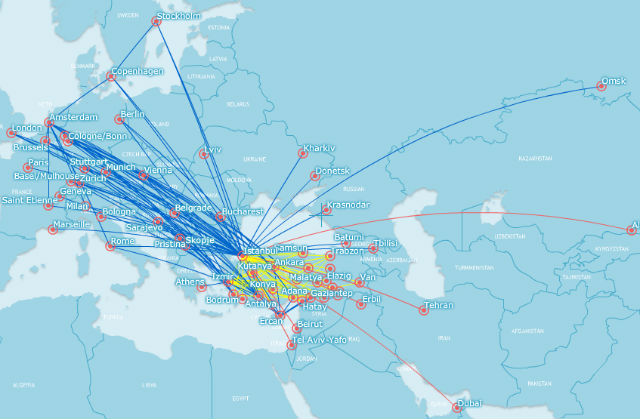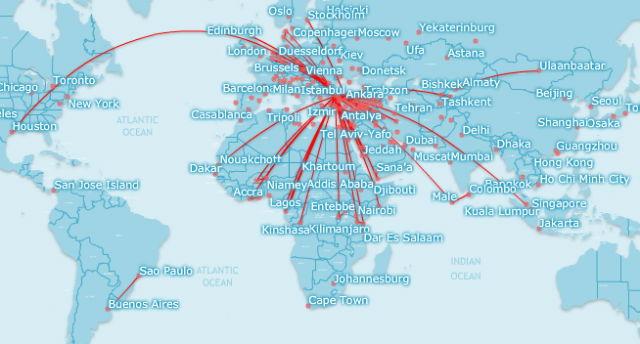Nearly a century since the collapse of the Ottoman dynasty, a new international empire is emerging from Turkey, and with expansionist ambitions on every populated continent, this swiftly rising power is threatening to exert an unrivalled global reach.
However, unlike the imperialist growth of Ottoman territory, the development of Turkey's aviation empire is organic. Its carriers are adding capacity and opening routes at an astonishing pace, often taking advantage when other airlines in Europe and elsewhere have been cutting them.
In the decade since deregulation, combined passenger traffic at the country's airports has more than tripled, rising from 34 million in 2002 to 117 million in 2011, according to ICAO statistics, with big increases also expected for 2012 and 2013. During that time, the total number of aircraft in Turkey also more than tripled from 110 in 2002 to 349 in 2011 and the number of Turkish aviation companies rose to 155, while turnover reached $12 billion, according to the country's directorate general of civil aviation.
Despite a lack of overland transport infrastructure in a country whose landmass stretches from western borders with Greece and Bulgaria to Iran in the east, Serkan Kaptan, director of business development and strategy at Turkish airport operator TAV says that before deregulation, "there were very few point-to-point flights within Turkey". Previously he says that "people living in the northeastern part of the country flying to the holiday resorts in the southwest would have to fly via Istanbul".
After Turkey's Justice and Development party, which was elected in 2002, deregulated the country's air space to allow competition on domestic routes and eliminated the air tax, other carriers began offering scheduled services. "At the same time, the state airport authority invested a lot in the domestic airports," says Kaptan, with eight idle regional airports - two of which had never been used - refurbished and opened for service. The arrival in the marketplace of Atlasjet, Pegasus Airlines, Onur Air and Fly Air - which is no longer in service - provided increased competition, but "rather than sharing the market, they enlarged it", says Kaptan. As a result, he says Turkey recorded "a huge jump in traffic in 2004, 2005 and 2006".
The new airlines - which had previously offered private charted services - helped reduce ticket prices, allowing many Turkish residents to fly for the first time between cities in the country where travel by bus or car had previously been the only option.
Pegasus, Turkey's oldest private carrier, created a base at Istanbul's second airport, Sabiha Gökçen, in 2005. Using its Boeing 737 aircraft, it opened a route to country's capital, Ankara, and to the cities of Adana, Antalya, Trabzon and Van. It now operates 1,224 flights a week, including services to 47 nonstop destinations using its fleet of 36 737s, but the carrier has a further 80 aircraft on order, which includes 75 Airbus A320 family neos with 25 options. Having posted an operating profit of $112 million at an EBITDA level in 2012, the airline has selected banks for an initial public offering to fund fleet growth and flight network expansion, according to its offering prospectus.
Pegasus Airlines route network April 2012 |
|---|
Pegasus Airlines route network April 2013 |
However, it was not only Turkey's private carriers that profited from the newfound freedom brought about by liberalisation. Explaining the principle source behind the increase in passenger traffic, Kaptan says, "actually it's mainly related to Turkish Airlines' growth, to be perfectly frank."
Instead of suffering from increased competition after the loss of its monopoly, Turkish Airlines was in fact liberated from constraints on its ability to expand, notably from state interference in areas such as network and pricing.
Kaptan says the carrier is growing "because of Turkish Airlines' ambitious strategy, because of Istanbul's unique positioning". He says this location on the East-West corridor leaves it perfectly situated to pick up one-stop traffic between the world's two largest aviation markets of Asia and Europe. In addition, he says Istanbul is much better positioned than its Gulf rivals to transfer traffic from "the -stan countries" such as Kazakhstan, Turkmenistan and Uzbekistan, as well as Mongolia and China, "to most parts of Africa, sub-Saharan Africa and north Africa, to western Europe and to the USA".
Olivier Jankovec, Airports Council International's (ACI) director general for the European region says that most importantly Turkey's location "allows them [its carriers] to fly short and medium-haul into most of Europe which is not something that the Gulf carriers can do." In addition he says the country's population of 80 million, 10 times that of the United Arab Emirates, and with an average age of 29 and rising income levels is full of young aspiring flyers, providing a very strong domestic based demand to further develop its global hub positioning.
Kaptan says the Gulf carriers are at a disadvantage to Turkish Airlines, particularly when it comes to being able to match capacity to demand with narrowbody aircraft. This is especially so in Africa, where he says: "Turkish Airlines' 737-900s are an excellent choice for those markets, flying five to six hours' distance with almost a widebody capacity."
Growth in Turkish Airlines new routes since April 2012 |
|---|
However, while Turkey's geographical situation is an advantage to its airlines, it also an area of concern. Neighbouring Syria is riven by conflict, while Iraq has only recently re-established a fragile stability and Iran is increasingly at odds with the West over its nuclear ambitions. As Iraq, Iran and Libya are all areas of expansion for Turkey's carriers, further unrest in the region could have a serious impact on the operations of its airlines.
Room for growth
Crucial to growth for Turkish Airlines and much of the rest of the country's commercial aviation industry are the proposed plans to build the world's largest airport with a capacity of 150 million passengers a year, allowing airlines to significantly increase operations from those at Istanbul Ataturk airport, which is near to capacity. With a target date for the first phase of construction set for 2017, when the airport will have an initial capacity of 70 million passengers, the operator that successfully bids for the tender will be expected to fulfil one of the most ambitious-ever airport projects in only four years.
With notable recent examples of new airport delays, the feasibility of this timescale is open for debate, especially considering that it will be the largest-ever airport construction project attempted on greenfield land, as well as "the biggest full relocation of any airport", says Kaptan. Yet he says: "projects are implemented very quickly in Turkey, the decision process is very quick and the implementation equally rapid."
This is just as well, considering how quickly Ataturk is nearing its capacity limit, which Kaptan says is around 55 million passengers a year. It did not even feature in ACI's top 50 list of airports by traffic size five years ago, being smaller than Salt Lake City airport in the USA, which was in 50th place, with traffic of 22.2 million passengers that year. In 2010, Istanbul was the 37th busiest airport in the world with traffic of 32.2 million, while in 2012, traffic was 45 million, ranking it 20th.
ACI predicts that Ataturk's traffic will increase by 20% during 2013, meaning it would have handled more traffic than the European hubs of Madrid and Amsterdam. In 2014, should its traffic figures climb by another 15%, it would have outgrown Frankfurt airport to become Europe's third biggest hub after Charles de Gaulle and Heathrow.
Another major factor in the growth of commercial aviation in Turkey has been the country's general economic growth, which is enabling more of its population of over 80 million to travel than ever before. According to the World Bank, after a fall during the first years of the financial crisis, Turkey's GDP grew by 9.2% in 2010 and 8.5% in 2011. Shakeel Adam, managing partner at aviation consultancy Aviado Partners, feels that with GDP per capita in Turkey still relatively low - in 2011 it was $10,576, according to International Monetary Fund figures - there is still much room for growth in Turkey and as this happens, its population's ability to afford travel will further increase.
He believes that with Pegasus's core business in the leisure and price sensitive segments, which are the first to grow in booming economies, the carrier is also well-placed to capitalise on growth in the wider Turkish economy. "The challenge for Pegasus will be the same as for Turkish Airlines - how to grow sustainably at such a fast pace while controlling costs in an industry where profit is highly sensitive to small changes in factor input costs," he says.
Source: Airline Business


























